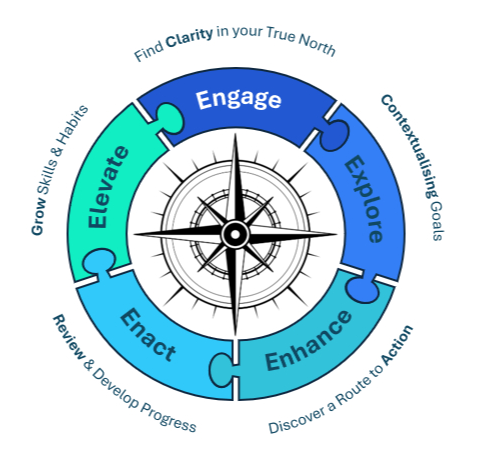Unlocking the Hidden Progress in Coaching
- Katy Eckert-Turnbull
- May 5
- 3 min read
Updated: Jul 31
One of the most common frustrations I hear from coaching clients, especially those in high-demand roles or undergoing transitions, is the feeling that they’re “not getting anywhere.” Despite regular coaching sessions, setting intentions, and making significant mindset shifts, many struggle to see or measure tangible progress. This disconnect between effort and visible outcomes can be a real barrier. It undermines motivation, creates doubt, and limits the very learning and change that clients are trying to embrace.
Understanding the Challenge
So, how do we make progress more visible, meaningful, and actionable? One tool I’ve explored deeply in my development as a coach is Reflective Action Planning, particularly in the context of setting and reviewing micro-goals - the small, focused performance goals that underpin larger transformations.
What Are Micro-Goals?
Micro-goals aren't merely smaller versions of larger goals. They are intentionally designed steps that focus on what a client does, rather than merely what they hope to achieve. These goals are performance-based, such as “initiate a difficult conversation this week” or “ask for feedback after my presentation.” They help to build habits, awareness, and capability over time.
However, even with micro-goals, clients can struggle to recognize their own growth. Why does this happen? Change often occurs subtly. Confidence shifts quietly. A behavioral change may feel unremarkable to the individual experiencing it, especially if they’re looking for dramatic outcomes.
The Role of Reflective Action Planning
This is where Reflective Action Planning shines. Unlike a simple to-do list, this approach encourages clients to reflect before and after each action. It includes structured questions such as:
What am I aiming to learn or test through this goal?
What assumptions am I bringing to this task?
What happened during this experience?
What did I notice about my reactions or behaviors?
What might I change next time?
By incorporating this kind of reflection, clients are not just doing - they are learning from the doing. More importantly, they begin to see the learning, giving shape and visibility to progress that otherwise remains intangible.
Overcoming the “Progress Blind Spot”
In my practice, I’ve witnessed how clients can transition from discouragement to momentum simply by noticing what has shifted. For instance, I worked with a leader who felt “stuck” despite attending coaching regularly. By employing reflective action planning over several weeks, they began to identify changes in how they approached decision-making, responded to conflict, and managed their time. What felt like a plateau was, in fact, meaningful progress - they just didn’t have the tools to name or track it.
This reflective approach not only boosts confidence but also fosters accountability. Clients can trace back through a reflective trail which illustrates the evolution of their thinking and behavior. It becomes a powerful source of evidence, motivation, and learning.
For Coaches: Self-Reflection is Key
As coaches, it’s easy to focus solely on the tools we provide our clients. But how often do we examine these tools ourselves? My own deep dive into reflective action planning was part of a personal commitment to explore how learning and behavioral change happen in real, lived contexts. Through supervision, peer learning, and experimentation, I’ve integrated this tool more effectively and can support clients in ways that truly move the needle.
Embracing Continuous Improvement
Coaching is a journey of continuous improvement. As both coaches and clients, we should embrace this mindset. Reflective practice will help us develop deeper insights. This fosters a cycle of learning that sharpens our skills and enhances our effectiveness.
Final Thoughts
Progress in coaching often isn’t immediately obvious, but it is happening. When we help clients reflect meaningfully on their micro-goals, we bring clarity to change, shape to learning, and motivation to move forward.
So if you're a coach or a client feeling like you’re “not getting anywhere,” it may be time to pause and look more closely. The progress you’re seeking might already be underway. Embrace the journey, and recognize that every small step contributes to your larger goals.
By using reflective practices, we can unveil the growth that may be hidden beneath the surface. This approach not only clarifies our journey, but it also celebrates the milestones we achieve along the way.




Comments